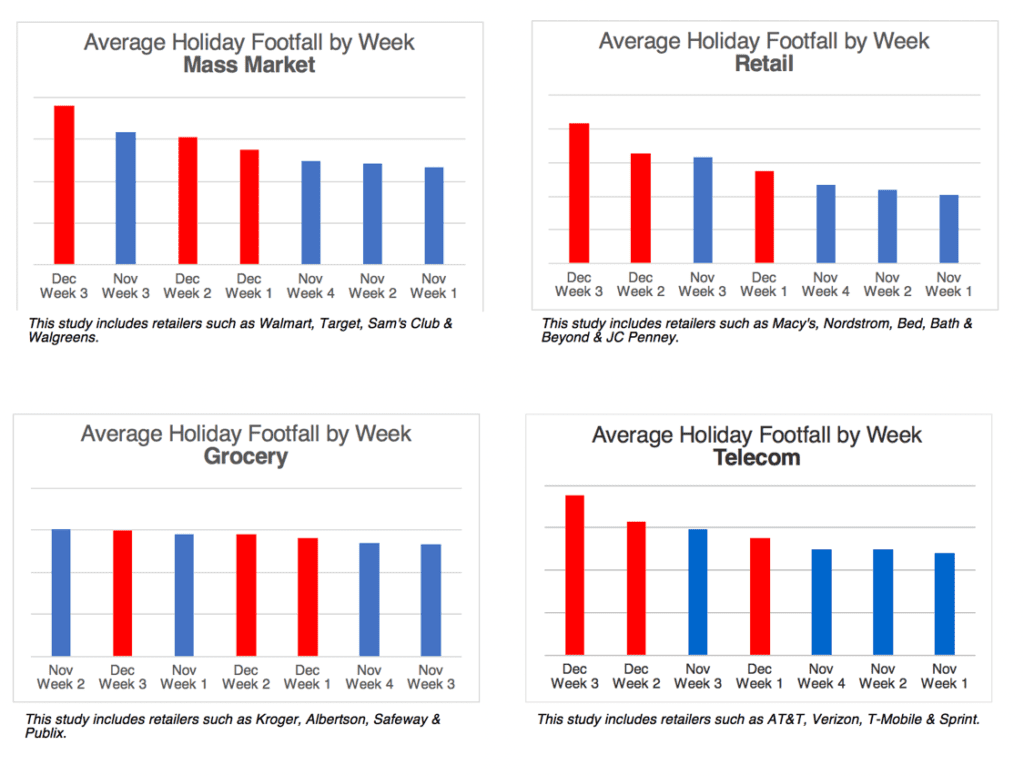With the US economy humming, growing at its fastest rate in over a decade while unemployment nears 20-year lows, the 2018 holiday shopping season promises to be a good one for retailers. Some estimates predict holiday retail sales increasing 5–6% this year, and the average American consumer is expected to spend a little over $1,500 on holiday expenditures, a whopping 25% increase from last year.
This incremental disposable income will be a boon to retailers across channels and verticals. While online shopping has become an undeniably convenient way to purchase some items, over half of Americans still plan to go to brick-and-mortar locations to do their holiday shopping. In fact, according to a Deloitte Study, shoppers in November and December make an average of seven trips to a physical store to complete their seasonal purchases.
So how can marketers capitalize on these high-value, in-store visits, and when are consumers most likely to be shopping?
Within Cuebiq’s location intelligence platform — which leverages the largest database of accurate and anonymous location data in the US — we used location analytics to see average footfall trends across the top holiday shopping weeks in 2017.
Based on the top holiday-shopping verticals such as Mass Market, Retail, Grocery, and Telecom, we looked at 4 to 5 of the top brands for each vertical to gauge footfall during the most critical weeks in November and December for holiday shopping.
Our intelligence revealed December as being the month with the highest in-store foot traffic, especially the week before Christmas (Dec. Week 3). See below for a top-level view of the average footfall trends by week for each vertical. For a deeper dive into the platform’s capabilities and insights, please contact a Cuebiq sales representative for a custom report.
Are Advertisers Spending Enough in December?
While shoppers flock to brick-and-mortar locations during December, advertising budgets seem to be going in the opposite direction. A recent survey of 100 leading US retailers found that 25% of advertising budgets are spent around Black Friday weekend, while only 5% are left for the week before Christmas. Given the trends in foot traffic, this approach seems a bit backward.
So, while budgets for Black Friday are already planned out, it’s not too late for marketers to capitalize on driving in-store traffic and incremental sales in the weeks leading up to Christmas by using location intelligence for smarter audience targeting. If retailers can save more of their budget for those final few weeks of shopping before the new year, they can reach users at a less-saturated moment while delivering a message to shoppers known to buy in-store.
Leverage Location-Based Audiences for Last-Minute Holiday Shoppers
When it comes to holiday shopping, it’s more important than ever to ensure you reach all potential audience segments who might be interested in your brand, thereby maximizing your ROI. To this end, it’s crucial to identify any new audience segments that you might be missing such as users exhibiting cross-shopping behaviors and those who may be at high risk for shopping with your competitor this season:
Loyal Audiences:
Over three-fourths (77%) of holiday shoppers plan on buying from the same retailers they did last year ( Deloitte study). Retailers can capture these last-minute loyalists by targeting brand loyal consumers with relevant messaging. Brand loyalists are ripe for targeting with last-minute deals, since they have demonstrated an affinity for your brand and are more inclined to spend those last-minute shopping dollars with you.
Predictive Audiences:
Through predictive audiences, you can target consumers who are more likely to switch brand loyalties. Cuebiq’s Predictive Audiences use changes in historical visitation patterns such as frequency of visit to a brand and visits to competitive brands to make predictions about which consumers are most likely to shop at competitive locations and which ones will continue to stay loyal. Using predictive audiences allows you to align your ad impressions with high-value consumers who are on the verge of switching brand loyalties. By understanding changes in behavior, marketers can identify consumers who will be more receptive to last-minute holiday offers.
Custom Audiences:
Target consumers who match your buyer personas and campaign parameters by activating custom audiences, such as consumers who might not visit your brand but are active spenders within your industry vertical. For example, you can use “day-parting” to understand the most popular time of day consumers visit similar brand locations, and then create segments based on time of visit.
Cuebiq Audiences offer a variety of Audience segments available for activation that can help marketers reach high-value shoppers, driving performance and helping retailers find success during this crucial time of year.




